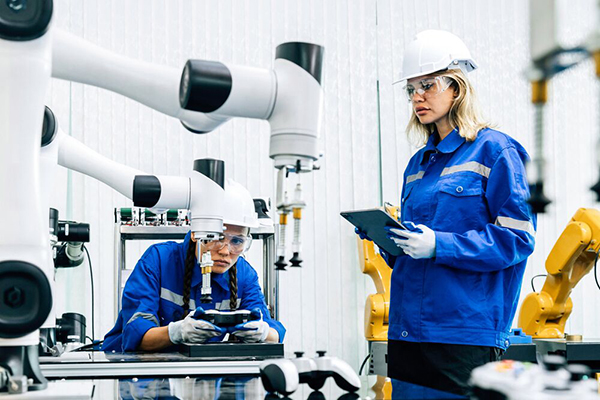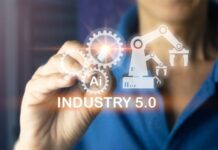If you’ve been anywhere near the industrial sector in the past decade, you’ve likely heard the term “Industry 4.0” countless times. On the highest level, Industry 4.0 leverages the plethora of new technologies in our world, such as robotics and machine learning, and applies them to the industrial sector.
The goal of Industry 4.0 was to improve the productivity and efficiency of the factory to create cheaper, higher quality, and more accessible goods. While Industry 4.0 represented marked improvement and transformation in the industrial sector, it still missed the mark in many ways. Unfortunately, Industry 4.0 focused so heavily on technology that it lost sight of the real, human-level goals.
Now, as Industry 4.0 becomes mainstream, Industry 5.0 is emerging as the next great transformation to the industrial sector. Although still in its infancy, this field could be revolutionary if approached correctly.
Industry 5.0 is still taking shape, and we now have an opportunity to ensure that it becomes what we need it to be—and what Industry 4.0 lacked. Let’s use the lessons learned from Industry 4.0 to make Industry 5.0 something that will benefit the world.
Industry 4.0: A Brief Background
The industrial sector has been defined largely by a series of different “revolutions” throughout its history. Industry 4.0 is the most recent of these revolutions.
At its inception, Industry 4.0 defined a national strategic initiative from the German government to improve manufacturing in Germany through the adoption of technology. Specifically, the Industry 4.0 initiative aimed to increase the digitization of the factory, add more data to the factory floor, and facilitate the interconnection of factory devices. Today, Industry 4.0 has been adopted widely by the industrial sector.
Big data, in particular, have enabled the growth of Industry 4.0. Today’s factory floors are full of sensors that monitor the state of industrial equipment and processes to provide factory operators with greater insight and transparency into the state of their facilities. As part of this, factory devices often are interconnected through a network in order to share data and communicate in real time.
Industry 5.0: The Next Great Revolution
Although Industry 4.0 succeeded in integrating advanced technology to increase efficiency, we have begun to realize missed opportunities to transform the world and have turned our attention to Industry 5.0 as the next great industrial revolution.
On the highest level, Industry 5.0 is an emerging concept that would integrate humans and advanced technologies to drive innovation, productivity, and sustainability in the industrial sector. Building upon the advancements of Industry 4.0, Industry 5.0 emphasizes the human factor and seeks to combine the strengths of both humans and machines.
At its core, Industry 5.0 recognizes that while automation and digitization have revolutionized industrial processes, humans possess unique qualities such as creativity, critical thinking, problem-solving, and emotional intelligence that are invaluable in driving innovation and addressing complex challenges. Rather than replacing humans with machines, Industry 5.0 seeks to leverage these human qualities and pair them with the capabilities of advanced technologies to create a more productive and inclusive industrial ecosystem.
If approached correctly, Industry 5.0 could represent an industrial revolution of a magnitude not yet experienced by the industrial sector. For this to happen, however, we need to harness the lessons learned from Industry 4.0.
Humanistic Approach
One significant shortcoming of Industry 4.0 was that it focused too much on the technological aspect and not enough on the human element. Technology is great, but ultimately, it’s only a tool. For real change to happen, Industry 5.0 needs to take a humanistic approach to manufacturing.
Industry 5.0 can integrate a human element into the technology by shifting the design focus. In Industry 4.0, technology was paramount, and human intervention and cooperation were lesser concerns. For example, many factories have entire sections of automated industrial equipment that are completely siloed from humans, often for safety concerns. However, this technology-first design philosophy does not consider that the humans in the factory are going to be fundamentally impacted by the new technologies.
Thus, Industry 5.0 is starting to focus on the idea of human–machine collaboration. For example, co-bots are robotics designed to work in unison with humans in a safe and more productive way. By taking this human-first approach, Industry 5.0 could improve collaboration, creativity, and decision-making in ways that Industry 4.0 simply could not.
Beyond just design, Industry 5.0 emphasizes the concept of human-first approaches to understanding the consumer. The world is undergoing significant changes in terms of consumer trends and supply chains. For example, one growing trend in consumer behavior is an increased demand for customized and personalized products. Unfortunately, the industrial sector often is disengaged with these changes, leaving it incapable of meeting dynamic consumer demands.
Hence, for Industry 5.0 to have the desired impact, it needs to take a human-first approach to consumer behavior. Instead of simply considering which technologies can be integrated to improve efficiency, factory operators need to consider what consumers want and what technologies can be integrated to meet those demands.
The difference between these perspectives may seem subtle, but the impact is significant.
Circular Economy
A huge missed opportunity in Industry 4.0 was that, overall, sustainability was not considered.
While greater efficiency in the factory may increase yields, which may be considered more sustainable, often, the processes and philosophies that underlie Industry 4.0 are far from sustainable. Ultimately, the shortcomings in Industry 4.0—from a sustainability perspective—stem from the lack of a circular economy.
In today’s manufacturing industry, raw materials are sourced, and goods are produced, consumed, and discarded. This open-loop system is inherently unsustainable; materials are wasted and dumped in landfills despite the fact that a significant amount of these materials could be reintroduced into the economy for reuse (i.e., a circular economy). Today, a desperate need exists to move from the conventional linear manufacturing model to a more circular model.
A major key to unlocking a more circular manufacturing model is to embrace data sharing, either across silos inside of the enterprise or across the supply chain from enterprise to enterprise. Today, many linear business models actually disincentivize stakeholders across the supply chain from sharing data. For example, consumers may be concerned that the more vehicle data they share with an insurance company, the less chance they have of securing affordable coverage.
Ultimately, the goal of a circular economy is to maximize the use of resources and minimize waste. If we incentivize data sharing across sectors, Industry 5.0 can help optimize resources by providing organizations with the information to unlock supply-chain transparency and better understand production needs. To do this, a fundamental shift in how we consider leveraging technology inside of manufacturing and how manufacturing relates to the circular economy as a whole is needed.
The industrial sector should make the world a better place to live; unless we’re taking steps to make things more sustainable, we’re not achieving that goal. To ensure a better and more sustainable future, Industry 5.0 must embrace the circular economy as a fundamental tenet.
Conclusion
Industry 4.0 marked a notable increase in factory productivity and efficiency, but it ultimately fell short of the envisioned “revolution.” As Industry 5.0 builds momentum, we have a unique opportunity to apply the lessons learned from Industry 4.0.
Some say that “Industry 5.0 is just Industry 4.0 with a soul.” Making this dream a reality requires emphasizing a human-first design approach, embracing a circular economy and manufacturing model, and committing to build a better world. If we learn from the past and build Industry 5.0 intelligently and thoughtfully, we might unlock a true revolution in the industrial sector.















